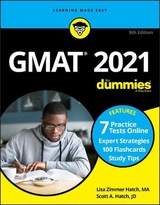
GMAT For Dummies 2020
John Wiley & Sons Inc (Verlag)
978-1-119-61794-5 (ISBN)
- Titel erscheint in neuer Auflage
- Artikel merken
Administered around the world, the GMAT measures verbal, mathematical, and analytical writing skills to assess qualifications for advanced study in business and management. This new edition of GMAT For Dummies with Online Practice includes proven tips and strategies to help you prepare for the GMAT and achieve ultimate success on test day.
The 2020 GMAT test structure has changed slightly, and this revised edition of the trusted test-prep book addresses those changes—including the number of questions per section and the time allotted per section—to make you feel more confident than ever.
Two practice tests in the book, plus FIVE more online for a total of SEVEN practice tests
Review of foundational concepts for every section
Complete explanations of every question type
Online practice and flash cards
When you have your heart set on scoring high on the GMAT, you only need one ace up your sleeve—and this book is your ticket to success.
Lisa Zimmer Hatch, MA, and Scott A. Hatch, JD, have been helping students succeed on standardized tests since 1987. They have written curricula and numerous test-prep guides and have taught internationally through their online forums, live lectures, DVDs, and study programs.
Introduction 1
About This Book 1
Foolish Assumptions 2
Icons Used in This Book 2
Beyond the Book 3
Where to Go from Here 3
Part 1: Getting Started with the GMAT 5
Chapter 1: The Lowdown on the GMAT 7
Knowing Why the GMAT is Important 7
Timing It Perfectly: When to Take the GMAT (And What to Bring) 8
When to register for and take the GMAT 8
Things to take to the GMAT (and things to leave at home) 10
Forming First Impressions: The Format of the GMAT 10
Getting familiar with what the GMAT tests 10
Understanding the computerized format 11
Honing your computer skills for the GMAT 12
Knowing Where You Stand: Scoring Considerations 13
How the GMAT testers figure your score 13
How the GMAT testers report your score 13
Why you should (almost) never cancel your GMAT score 14
Repeating the Process: Retaking the GMAT 15
Chapter 2: Maximizing Your Score on the GMAT 17
Discovering Strategies for Successful Guessing 17
Forcing yourself to guess so you can move on 18
Understanding the importance of completing each section 18
Winning the Race against the Clock 19
Giving each question equal treatment 19
Making time for the last ten questions 19
Keeping track of your pace 20
Getting Rid of Wrong Answers 20
Keeping track of eliminated answer choices for the computer test format 20
Recognizing wrong answers 21
Playing It Smart: A Few Things You Shouldn’t Do When Taking the Test 25
Don’t lose your focus 25
Don’t read questions at lightning speed 25
Don’t waste all your time on the hardest questions 25
Don’t cheat 26
Tackling a Case of Nerves with Relaxation Techniques 26
Devising a Plan of Attack 27
Chapter 3: Mastering Business School Admissions 29
Choosing a Business School 29
Lining Up Your Ducks — Applying to Business Schools 31
When to apply 32
What to submit 32
Crafting Effective Business School Essays 33
Part 2: Vanquishing the Verbal Section 35
Chapter 4: Applying What You Learned (We Hope) in Grammar Class: Sentence Correction 37
Building a Solid Foundation: Grammar Basics 38
Getting wordy: The parts of speech 38
Pulling together: The parts of a sentence 40
Pointing Out Mistakes: Common Sentence Correction Errors 42
Can’t we all just get along? Errors in subject-verb and noun-pronoun agreement 43
Building code violations: Faulty construction 45
Follow the idiom: Correct use of standard expressions 48
Implementing an Approach to Sentence Correction Questions 51
Spotting the error 51
Eliminating answers that don’t correct errors 52
Eliminating choices that create new errors 52
Rereading the sentence 53
Reviewing the process and guessing on sentence corrections 53
Sentence Correction Practice Problems with Answer Explanations 53
Practice problems 54
Answer explanations 56
Chapter 5: Not as Enticing as a Bestseller: Reading Comprehension 59
Judging by Appearances: What Reading Comprehension Questions Look Like 59
Approaching Reading Passages 60
Mastering the message: The main point 60
Absorbing the ambiance: Author’s tone 61
Finding the framework: The passage’s outline 61
Sticking to the Subject: Types of Passages 62
Experimenting with natural science passages 62
Gathering in social circles: Social science passages 62
Getting down to business passages 63
Approaching Reading Comprehension Questions 63
Identifying the question type 63
Eliminating answer choices 66
Dealing with exception questions 67
Reading Comprehension Practice Questions with Answer Explanations 70
Reading comprehension practice questions 70
Answer explanations 74
Chapter 6: Thinking This through Logically: Critical Reasoning 79
Focusing on “Critical” Concepts: An Overview 79
Understanding the structure of the questions 80
Figuring out how to answer the questions 80
Making a Case: Essentials of Informal Logic 81
Fighting fair: The elements of an argument 81
Getting from Point A to Point B: Types of reasoning 81
Thinking Inside the Box: Question Types 83
Stalking Your Prey: How to Approach Each Question Type 84
Strengthening or weakening arguments 84
Delving into drawing conclusions 88
Spotting those sneaky assumptions 89
Using your noggin to make inferences 91
Critical Reasoning Practice Questions and Answer Explanations 94
Critical reasoning practice questions 94
Answer explanations 98
Chapter 7: Bringing It Together: A Mini Practice Verbal Section 103
Working Through Verbal Reasoning Practice Questions 104
Understanding What’s Right with Answer Explanations 113
Part 3: Acing the Analytical Writing Section 121
Chapter 8: Analyze This: What to Expect from the Analytical Writing Assessment 123
Fitting in the AWA with the Rest of the GMAT 123
Calling 411: Your AWA Writing Tools 124
Analyzing an Argument 124
Racking Up the Points: How the GMAT Scores Your Essay 125
Getting to know your readers 125
Interpreting the scores 126
Requesting your essay be rescored 126
Chapter 9: Present Perfect Paragraphs: How to Write a GMAT Essay 127
Avoiding Grammar, Punctuation, and Mechanics Errors 127
Punctuation errors 128
Sentence-structure problems 129
Faulty forming of possessives 129
Spelling issues 129
More dos and don’ts 130
Practice makes perfect! 130
Building a Better Essay: Ten Steps to a Higher Score 131
Chapter 10: Deconstructing Sample GMAT Essays 133
Defining GMAT AWA Scores 133
Taking a Look at Sample Essays 134
Sample essay #1 135
Discussion of sample essay #1 136
Sample essay #2 136
Discussion of sample essay #2 137
Sample essay #3 138
Discussion of sample essay #3 139
Sample essay #4 139
Discussion of sample essay #4 140
Chapter 11: Sampling a Series of Writing Prompts 141
Sample Prompt #1 141
Sample response to essay #1 142
Dissection of essay #1 142
Sample Prompt #2 143
Sample response to essay #2 143
Dissection of essay #2 144
Sample Prompt #3 144
Sample response to essay #3 145
Dissection of essay #3 145
Sample Prompt #4 146
Sample response to essay #4 146
Dissection of essay #4 146
Part 4: Conquering the Quantitative Section 149
Chapter 12: Getting Back to Basics: Numbers and Operations 151
Just Your Type: Kinds of Numbers 151
It’s Not Brain Surgery: Basic Operations 153
Adding, subtracting, multiplying, and dividing 153
Checking out the real estate: Properties of real numbers 155
Using Little Numbers for Big Values: Bases and Exponents 157
Adding and subtracting with exponents 158
Multiplying and dividing with exponents 158
Figuring out the powers of 0 and 1 158
Dealing with fractional exponents 159
Working with negative exponents 159
Checking Out the Ancestry: Roots 160
Order of Operations: Please Excuse My Dear Aunt Sally 161
Splitting Up: Fractions, Decimals, and Percentages 162
Defining numerators, denominators, and other stuff you need to know about fractions 163
Adding and subtracting fractions 164
Multiplying and dividing fractions 165
Calculating percent change 167
Taking it further: Repeated percent change 168
Making Comparisons: Ratios and Proportions 169
Playing the Numbers: Scientific Notation 170
Chapter 13: Considering All the Variables: Algebra 171
Defining the Elements: Algebraic Terms 171
Braving the unknowns: Variables and constants 171
Coming together: Terms and expressions 172
Knowing the nomials: Kinds of expressions 172
Maintaining an Orderly Fashion: Algebraic Operations 173
Adding to and taking away 173
Multiplying and dividing expressions 175
Extracting Information: Factoring Polynomials 177
Something in common: Finding common factors 177
Two by two: Factoring quadratic polynomials 178
Minding Your Ps and Qs: Functions 179
Standing in: Understanding function terminology 180
Taking it to the limit: Domain and range of functions 181
Putting On Your Thinking Cap: Problem Solving 184
Isolating the variable: Linear equations 184
Bringing in the substitution: Simultaneous equations 185
Not playing fair: Inequalities 187
Solving quadratic equations 189
Reading between the lines: Word problems 190
Burning the midnight oil: Work problems 192
Going the distance: Distance problems 193
Chapter 14: Getting the Angle on Geometry: Planes and Solids 195
Fishing for the Answers: Lines and Angles 195
Trusting Triangles 198
Triple treat: Types of triangles 198
The area of a triangle 200
The Pythagorean theorem and other cool stuff about right triangles 200
A striking resemblance: Similar triangles 203
Playing Four Square: Quadrilaterals 204
Drawing parallels: Parallelograms 205
Raising the roof: Trapezoids 206
Showing Their Good Sides: Other Polygons 207
Eating Up Pieces of Pi: Circles 208
Ring measurements: Radius, diameter, and circumference 208
Blueprints for Noah: Arcs 208
Line ’em up: Chords, inscribed and circumscribed figures, and tangents 209
Getting a Little Depth Perception: Three-Dimensional Geometry 211
Chipping off the old block: Rectangular solids 211
Sipping from soda cans and other cylinders 213
Chapter 15: Keeping in Step: Coordinate Geometry 215
Taking Flight: The Coordinate Plane 215
Line dancing: Understanding coordinate geometry 215
What’s the point? Finding the coordinates 216
On all fours: Identifying quadrants 216
Slip-Sliding Away: Slope and Linear Equations 217
Taking a peak: Defining the slope of a line 217
Using the slope-intercept form to graph lines 219
Meeting in the middle 221
Going the distance 222
Considering other shapes on the coordinate plane 223
Fully Functioning: Graphing Functions 224
Passing the vertical line test 224
Feeling at home with domain and range 226
Chapter 16: Manipulating Numbers: Statistics and Sets 229
Joining a Clique: Groups 229
Setting Up Sets 231
Set terminology 231
Getting a visual: Venn diagrams 231
Making Arrangements: Permutations and Combinations 233
Positioning with permutations 233
Coming together: Combinations 235
Meeting in the Middle: Mean, Median, and Mode 237
Straying from Home: Range and Standard Deviation 239
Scouting out the range 239
Watching out for wanderers: Standard deviation 239
Predicting the Future: Probability 241
Finding the probability of one event 241
Finding the probability of many events 242
Chapter 17: It’s All in the Presentation: GMAT Quantitative Question Types 245
Enough’s Enough: Data Sufficiency Questions 245
You don’t need the solution to find the answer 246
Steps to approaching data sufficiency problems 246
Taking a Look at Data Sufficiency Practice Problems 249
Practice questions 249
Answer explanations 251
Houston, We Have a Problem: Problem Solving Questions 255
Trying Out Some Problem Solving Practice Problems 257
Practice questions 257
Answer explanations 259
Chapter 18: All Together Now: A Mini Practice Quantitative Section 263
Tackling GMAT Math Practice Questions 263
Checking Out the Answer Explanations 270
Part 5: Excelling on the Integrated Reasoning Section 281
Chapter 19: Best of Both Worlds: The Integrated Reasoning Section 283
Understanding What the IR Section is All About 283
Skills tested 284
Question format 284
Figuring Out How the IR Section is Scored 286
Making the Most of Your Time 286
Approaching Each Question Type 287
Table analysis 287
Two-part analysis 290
Graphics interpretation 293
Multi-source reasoning 294
Chapter 20: Deciphering Data in Charts and Graphs 299
Approaching Integrated Reasoning Data in Five Easy Steps 299
Translating Information in Tables 300
Making Comparisons with Bar Graphs 301
Simple bar graphs 301
Graphs with many bars 301
Segmented bar graphs 302
Evaluating Line Graphs 304
Basic line graphs 304
Scatter plots 304
Complex scatter plots 306
Clarifying Circle Graphs (Also Known as Pie Charts) 307
Extracting Data from Venn Diagrams 307
Part 6: Practice Makes Perfect 311
Chapter 21: GMAT Practice Test 313
Answer Sheet 315
Section 1: Analytical Writing Assessment 318
Section 2: Integrated Reasoning 319
Section 3: Quantitative 320
Section 4: Verbal 327
Chapter 22: Practice Test Answers and Explanations 339
Section 1: Analytical Writing Assessment 339
Section 2: Integrated Reasoning 341
Section 3: Quantitative Reasoning 341
Section 4: Verbal 356
Answers at a Glance 365
Part 7: The Part of Tens 367
Chapter 23: Ten Question Types You’ve Got a Good Shot At 369
Main-Theme Reading Questions 369
Specific Information Reading Questions 369
Sentence Corrections 370
Exception Questions for Reading Passages 370
Strengthening or Weakening Critical Arguments 370
Data Sufficiency Math Questions 370
Math Problem Solving with Figures 370
Math Problems Involving Basic Operations 370
Substitution Math Problems 371
Graph- and Table Analysis Questions 371
Chapter 24: Ten Writing Errors to Avoid 373
Composing Complicated Sentences 373
Presenting Your Text in Passive Voice 373
Wasting Time with Unfamiliar Words 373
Using Unclear (Or Zero) Transitions 374
Going Overboard with Generic Terms 374
Writing in Informal English 374
Giving a Laundry List of Examples 374
Succumbing to Sentence Fragments 374
Announcing a Position without Explanation 374
Putting Aside Proofreading 374
Chapter 25: Ten Ways to Increase Your Chances of Getting into Business School 375
Accumulate a Little Work Experience 375
Ace the Interview 375
Apply Early 376
Apply While You’re Upwardly Mobile 376
Capitalize on What Makes You Unique 376
Demonstrate Interest 376
Focus on Fit 376
Get the Right Recommendations 377
Study for the GMAT 377
Write a Memorable Admissions Essay 377
Index 379
| Erscheinungsdatum | 18.02.2020 |
|---|---|
| Verlagsort | New York |
| Sprache | englisch |
| Maße | 216 x 275 mm |
| Gewicht | 750 g |
| Themenwelt | Sozialwissenschaften ► Pädagogik ► Berufspädagogik |
| Wirtschaft ► Betriebswirtschaft / Management ► Allgemeines / Lexika | |
| ISBN-10 | 1-119-61794-4 / 1119617944 |
| ISBN-13 | 978-1-119-61794-5 / 9781119617945 |
| Zustand | Neuware |
| Informationen gemäß Produktsicherheitsverordnung (GPSR) | |
| Haben Sie eine Frage zum Produkt? |
aus dem Bereich



